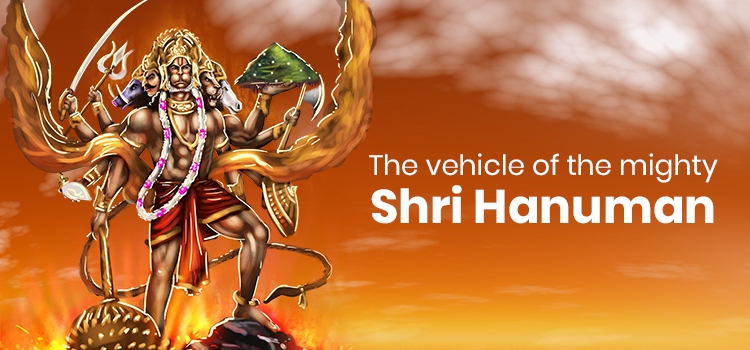The Vehicle of the Mighty Shri Hanuman
A remarkable feature of Hindu deities is that they are associated with particular animal-vehicles or vahanas. The Sanskrit word means "that which carries or pulls." These vehicles can be animals or birds, and they symbolize the spiritual and psychological forces that represent the deities. Their importance can be gauged from the fact that the deities are seldom depicted without their vahanas. The vahanas may sport a saddle on which the deity rides, or they are shown pulling a chariot driven by the deity. Sometimes they are seen walking alongside the deity. At times, they may have more than one vehicle, too.
However, the vahana can also represent the negative forces that the deity dominates. Thus, Lord Muruga controls the peacock's vanity. Seated on Mushika (rat), Ganesha crushes futile thoughts, which breed like rats in the dark. Shani, who is the protector of property, rides a vulture, raven, or crow and represses thieving tendencies.

Before he became Shiva’s vahana, the bull, Nandi, was a deity named Nandikeshvara, the Lord of joy and master of music and dance. But suddenly, his name and functions were transferred to the Nataraja aspect of Shiva. From being half-man, half-bull, he became a bull. Since then, he has kept watch over Shiva's temples and is always looking toward him.
In Hindu legends, these animal vahanas can act independently from their deities at times. But they perform the same functions as the deity in question. There are even myths about how each animal/bird became the vehicle of a particular deity.
Symbolism behind the Vehicles of Deities
Each deity's vehicle symbolizes his or her "power" or meaning. For instance:
- Goddess Saraswati’s vehicle is the graceful Hamsa or swan, which represents wisdom, beauty, and grace. It also signifies her association with the performing arts.
- Vishnu’s vahana ‘Garuda’ is also an upadevata or divine entity who represents birth and heaven.
- Shiva’s vehicle, Nandi, symbolizes brute power as well as sexual energy.
- Shiva's consort, Goddess Parvati, rides a lion, which represents mercilessness, anger, and pride, the vices she controls in her devotees.
- Some scholars feel that these divine vahanas represent the minds of the devotees, which are thereby controlled and guided by the deity.
Hanuman’s Vahana
It is believed that Hanuman’s vehicle is a camel. Though this is not mentioned in the Valmiki Ramayan, the Parashara Samhita does describe Hanuman riding a camel. There is a Sloka that says that Hanuman mounted a camel which is decorated with a golden seat cover and roamed about on the banks of Pampa Sarovar.
The camel is a desert animal and lives on desert plants like the cactus and thorns. It is well equipped to walk on sand. The geographical location of the Pampa Sarovar (present-day Hampi) is a sandy and hot terrain which features hills and rocks. It is not an easy place to navigate on foot. But a camel will be able to move without much difficulty as its feet are equipped to walk on such rough and sandy surfaces.
Hence, the camel may have been a good choice for Hanuman as he lived in Kishkinda. The Parashara Samhita says that Hanuman enjoyed a camel ride, and he was accompanied by his accomplices, Jambavant, Nal, Neela, Gandhamadana, etc. The camel is also a patient animal. It takes twice the effort for us to walk on sand. But the camel can travel long distances on sandy terrain. It can also run fast on the sand, which not many animals can do.
Hanuman had many siddhis, as he had received many boons from the gods as a child. He could even fly, and in fact, he flew over the ocean to Lanka in search of Sita. So why does he need a vehicle? An interesting story explains why.
Once, a great devotee of Hanuman did penance for many years, hoping to get his darshan. Lord Hanuman finally appeared before him, but the devotee was not satisfied. He told Hanuman that because of his nature of “vaayu vegam, mano vegam”, he came quickly, and before he could take a good look at him, he vanished. The devotee wanted to have a proper darshan of Hanuman and gaze on him until his heart was content.
Hanuman was moved by his devotion and appeared before him again. This time, he asked him what would make him happy. The devotee told Hanuman that he should use the camel as his vehicle so that he could take his time to see him in all his glory and splendor.
Hence, Lord Hanuman gave darshan to him on a camel. Supposedly, this was how the camel became Hanuman’s vehicle.




















